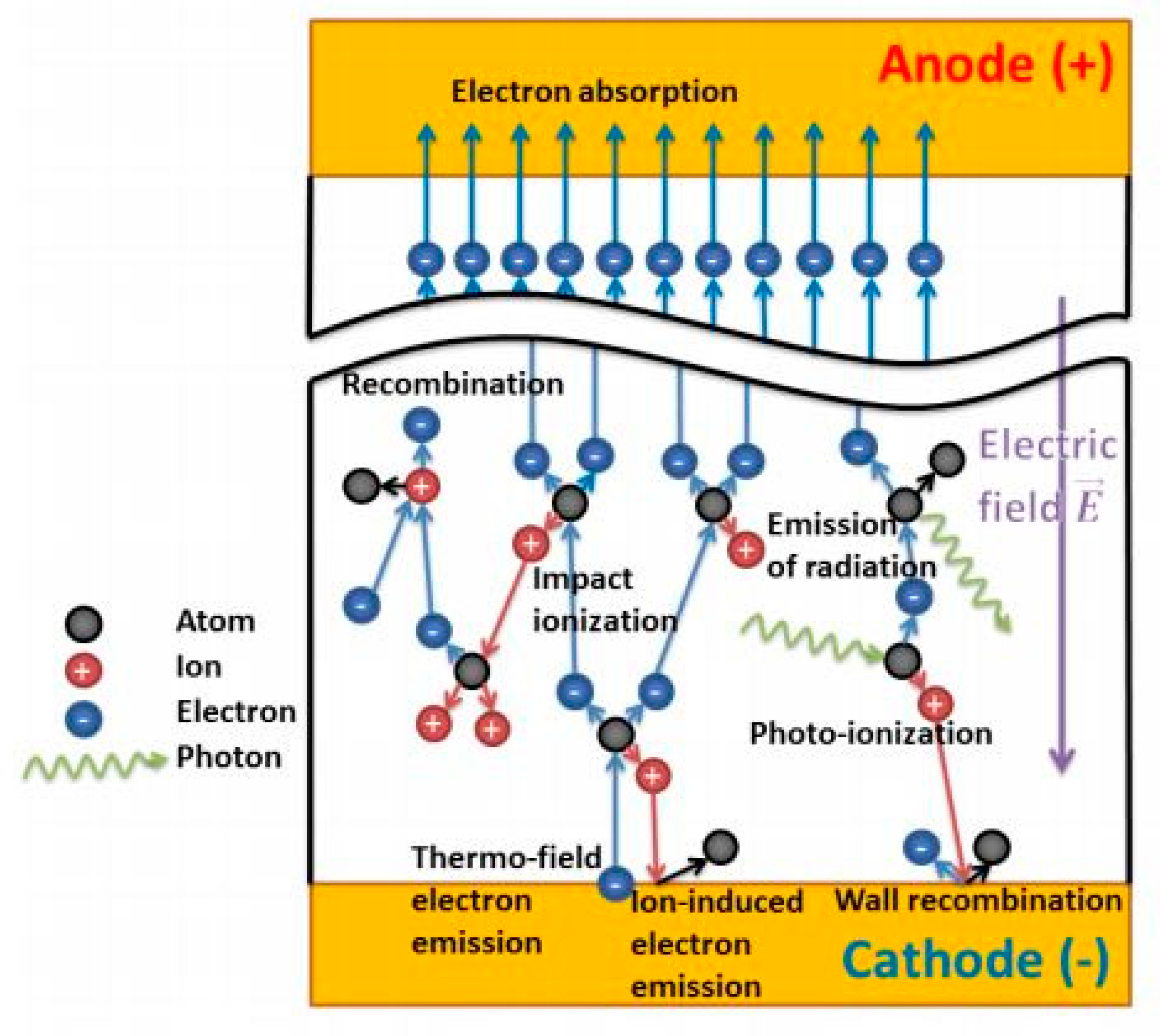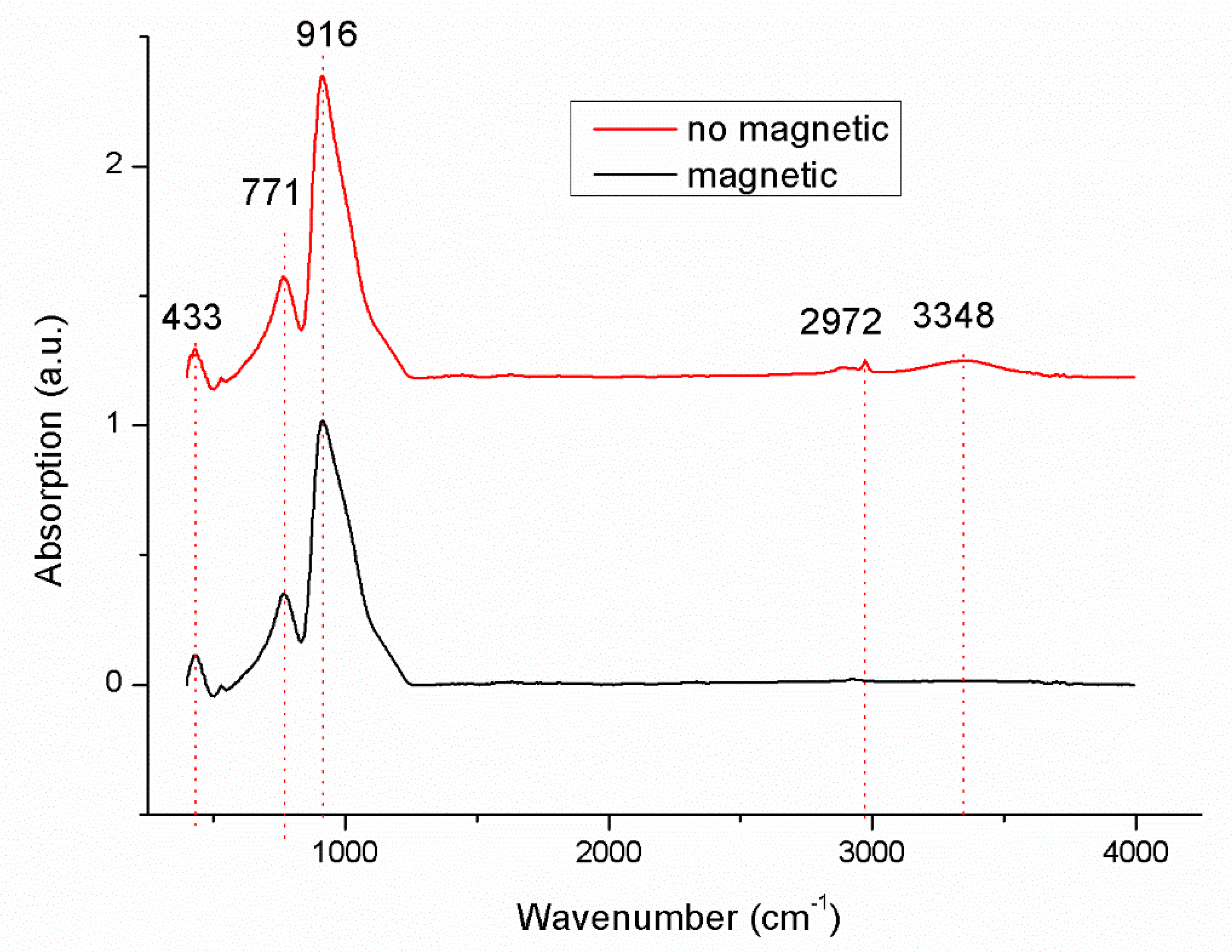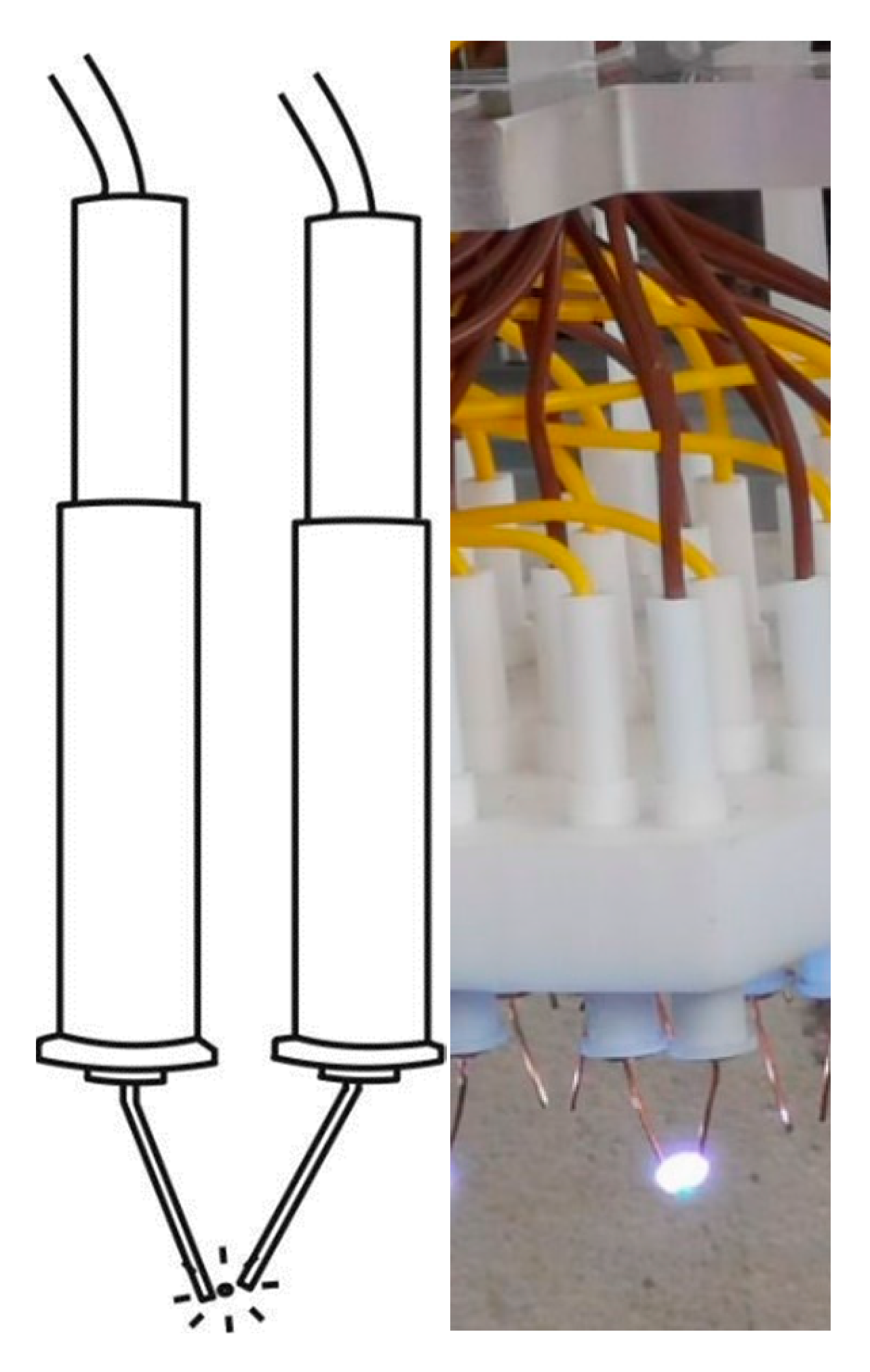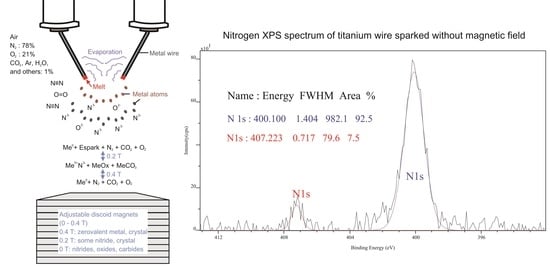The Effect of a Weak Magnetic Field (0 T to 0.4 T) on the Valence Band and Intramolecular Hydrogen of Inorganic Aerosol Metal–Nitrogen Gas Chemical Reactions in a Sparking Discharge Process
Abstract
Supplementary Materials
Author Contributions
Funding
Acknowledgments
Conflicts of Interest
References
- Stefan, R.; Jakmunee, J.; Punyodom, W.; Singjai, P. A novel strategy for longevity prolongation of iron-based nanoparticle thin films by applied magnetic force. New J. Chem. 2018, 42, 4807. [Google Scholar]
- Ručman, S.; Intra, P.; Kantarak, E.; Sroila, W.; Kumpika, T.; Jakmunee, J.; Punyodom, W.; Arsić, B.; Singjai, P. Influence of the magnetic field on bandgap and chemical composition of zinc thin films prepared by sparking discharge process. Sci. Rep. 2020, 10, 1. [Google Scholar]
- Aleksandrov, N.L.; Bazelyan, E. M Ionization processes in spark discharge plasmas. Plasma Sources Sci. Technol. 1999, 8, 285. [Google Scholar] [CrossRef]
- Kumar, S.; Supriya, S.; Pandey, R.; Pradhan, L.K.; Singh, R.K.; Kar, M. Effect of lattice strain on structural and magnetic properties of Ca substituted barium hexaferrite. J. Magn. Magn. Mater. 2018, 458, 30. [Google Scholar] [CrossRef]
- Ghaleb, F. Belasri, A Numerical and theoretical calculation of breakdown voltage in the electrical discharge for rare gases. Radiat. Eff. Defects Solids 2012, 167, 377. [Google Scholar] [CrossRef]
- Kohut, A.; Ludvigsson, L.; Meuller, B.O.; Deppert, K.; Messing, M.E.; Galbács, G.; Geretovszky, Z. From plasma to nanoparticles: Optical and particle emission of a spark discharge generator. Nanotechnology 2017, 28, 475603. [Google Scholar] [CrossRef]
- Kohut, A.; Galbács, G.; Márton, Z.; Geretovszky, Z. Characterization of a copper spark discharge plasma in argon atmosphere used for nanoparticle generation. Plasma Sources Sci. Technol. 2017, 26, 045001. [Google Scholar] [CrossRef]
- Kohut, A.; Villy, L.P.; Ajtai, T.; Geretovszky, Z.; Galbács, G. The effect of circuit resistance on the particle output of a spark discharge nanoparticle generator. J. Aerosol Sci. 2018, 118, 59. [Google Scholar] [CrossRef]
- Tabrizi, N.S.; Xu, Q.; Van Der Pers, N.M.; Schmidt-Ott, A. Generation of mixed metallic nanoparticles from immiscible metals by spark discharge. J. Nanoparticle Res. 2010, 12, 247. [Google Scholar] [CrossRef]
- Tabrizi, N.S.; Ullmann, M.; Vons, V.A.; Lafont, U.; Schmidt-Ott, A. Generation of nanoparticles by spark discharge. J. Nanoparticle Res. 2009, 11, 315. [Google Scholar] [CrossRef]
- Ručman, S.S.; Punyodom, W.; Jakmunee, J.; Singjai, P. Inducing Crystallinity of Metal Thin Films with Weak Magnetic Fields without Thermal Annealing. Crystals 2018, 8, 362. [Google Scholar] [CrossRef]
- Thongpan, W.; Louloudakis, D.; Pooseekheaw, P.; Kumpika, T.; Kantarak, E.; Panthawan, A.; Thongsuwan, W.; Singjai, P. Porous CuWO4/WO3 composite films with improved electrochromic properties prepared by sparking method. Mater. Lett. 2019, 257, 126747. [Google Scholar] [CrossRef]
- Hankhuntod, A.; Kantarak, E.; Sroila, W.; Kumpika, T.; Singjai, P.; Thongsuwan, W. α-Fe2O3 modified TiO2 nanoparticulate films prepared by sparking off Fe electroplated Ti tips. Appl. Surf. Sci. 2019, 477, 116. [Google Scholar] [CrossRef]
- Kumpika, T.; Thongsuwan, W.; Singjai, P. Optical and electrical properties of ZnO nanoparticle thin films deposited on quartz by sparking process. Thin Solid Film. 2008, 516, 5640. [Google Scholar] [CrossRef]
- Quintero, J.; Mariño, A.; Šiller, L.; Restrepo-Parra, E.; Caro-Lopera, F. Rocking Curves of Gold Nitride Species Prepared by Arc Pulsed - Physical Assisted Plasma Vapor Deposition. Surf. Coat. Technol. 2017, 309, 249. [Google Scholar] [CrossRef]
- Seki, I.; Yamaura, S.I. Reduction of Titanium Dioxide to Metallic Titanium by Nitridization and Thermal Decomposition. Mater. Trans. 2017, 58, 361. [Google Scholar] [CrossRef]
- Vahlas, C.; Ladouce, B.D.; Chevalier, P.Y.; Bernard, C.; Vandenbulcke, L. A thermodynamic evaluation of the Ti-N system. Thermochim. Acta 1991, 180, 23. [Google Scholar] [CrossRef]
- Kim, W.Y.; Jo, J.O.; Chung, T.I.; Kim, D.S.; Pak, J.J. Thermodynamics of Titanium, Nitrogen and TiN Formation in Liquid Iron. ISIJ Int. 2007, 47, 1082. [Google Scholar] [CrossRef]
- Jones, F.L. Electrode Erosion by Spark Discharges. Br. J. Appl. Phys. 1950, 1, 60. [Google Scholar] [CrossRef]
- Cundall, C.M.; Craggs, J.D. Electrode vapour jets in spark discharges. Spectrochim. Acta 1955, 7, 149. [Google Scholar] [CrossRef]
- De Rango, P.; Lees, M.; Lejay, P.; Sulpice, A.; Tournier, R.; Ingold, M.; Germi, P.; Pernet, M. Texturing of magnetic materials at high temperature by solidification in a magnetic field. Nature 1991, 349, 770. [Google Scholar] [CrossRef]
- Masahashi, N.; Matsuo, M.; Watanabe, K. Development of preferred orientation in annealing of Fe–3.25%Si in a high magnetic field. J. Mater. Res. 1998, 13, 457. [Google Scholar] [CrossRef]
- Tippo, P.; Thongsuwan, W.; Wiranwetchayan, O.; Kumpika, T.; Kantarak, E.; Singjai, P. Influence of Co concentration on properties of NiO film by sparking under uniform magnetic field. Sci. Rep. 2020, 10, 15690. [Google Scholar] [CrossRef] [PubMed]
- Foix, D.; Martinez, H.; Pradel, A.; Ribes, M.; Gonbeau, D. XPS valence band spectra and theoretical calculations for investigations on thiogermanate and thiosilicate glasses. Chem. Phys. 2006, 323, 606–616. [Google Scholar] [CrossRef]
- Morita, A. Theory of Cohesive Energies and Energy-Band Structures of Diamond-Type Valence Crystals: The Method of SLCO, II. Prog. Theor. Phys. 1958, 19, 534–540. [Google Scholar] [CrossRef][Green Version]




| Metal Wire | Position (eV) | FWHM (eV) | Atomic Conc. (%) |
|---|---|---|---|
| Nickel–air | 400.3/407.346 | 2.992 | 3.35 |
| Nickel–pure N2 | 400.089/398.744 | 2.687 | 2.92 |
| Cobalt–atmospheric air | 407.304/399.806 | 1.421 | - |
| Cobalt | 407.191/400.211/399.155 | 2.370 | 1.02 |
| Vanadium–air | 407.228/401.873/400.032 | 2.875 | 5.08 |
| Titanium | 407.223/400.100 | 2.576 | 1.97 |
| Vanadium | 401.500 | 2.488 | 4.20 |
| Tungsten | 401.800 | 2.842 | 4.68 |
| Metal | Conditions | Miller Indices | Crystallographic Reference |
|---|---|---|---|
| Iron (Fe) | 0 T, pure N2 | (002,211) and (111) | 73-2102 and 83- 087726 |
| Iron (Fe) | 0.2 T, pure N2 | (111,200,220) and (110) | 04-016-4995; 01-080-3816 |
| Iron (Fe) | 0.4 T, pure N2 | (110) | 98-000-0259 |
| Zinc (Zn) | 0.2 T and 0.4 T, pure N2 | (100) (212) (400) | 00-005-0664; 00-023-0740; 00-035-0762 |
| Tungsten (W) | 0.4 T, ambient air | (112) (211) | 00-041-1230; 03-065-6453 |
| Nickel | 0.4 T, ambient air | (111) and (200); (200) | 03-065-2865 01-083-8042 |
| Copper | 0.4 T, ambient air | (002) (11-1); (111) (200) | 01-080-0076. 03-065-9743 |
| Indium (In) | 0.4 T, ambient air | (101) (002) (110); (222) | 03-065-9292, 01-071-2194 |
| Time | Spark Energy | Temperature (°C) | pH | Conductivity (µS/cm) No Mag. Field | Conductivity (µS/cm) Mag. Field |
|---|---|---|---|---|---|
| 0 min | 0 kV 0 mA | 28 | 7 | 1.35 | 0.68 |
| 5 min | 4.75 kV 0.61 mA; 4.40 kV 0.55 mA; | 28 | 6.38 | 6.17 | 13.08 |
| 15 min | 4.78 0.57; 4.42 0.57; | 28 | 6.18 | 15.93 | 27.70 |
| 30 min | 4.76 0.58; 4.42 0.53; | 28 | 5.77 | 29.68 | 34.84 |
| 45 min | 4.77 0.58; 4.42 0.55 | 28 | 5.46 | 39.7 | 49.9 |
| 60 min | 4.85 0.60; 4.48 0.54; | 27 | 4.90 | 48.8 | 59.4 |
| 75 min | 4.9 0.6; 4.48 0.55 | 27 | 4.58 | 68.1 | 79.1 |
Publisher’s Note: MDPI stays neutral with regard to jurisdictional claims in published maps and institutional affiliations. |
© 2020 by the authors. Licensee MDPI, Basel, Switzerland. This article is an open access article distributed under the terms and conditions of the Creative Commons Attribution (CC BY) license (http://creativecommons.org/licenses/by/4.0/).
Share and Cite
Ručman, S.; Boonruang, C.; Singjai, P. The Effect of a Weak Magnetic Field (0 T to 0.4 T) on the Valence Band and Intramolecular Hydrogen of Inorganic Aerosol Metal–Nitrogen Gas Chemical Reactions in a Sparking Discharge Process. Crystals 2020, 10, 1141. https://doi.org/10.3390/cryst10121141
Ručman S, Boonruang C, Singjai P. The Effect of a Weak Magnetic Field (0 T to 0.4 T) on the Valence Band and Intramolecular Hydrogen of Inorganic Aerosol Metal–Nitrogen Gas Chemical Reactions in a Sparking Discharge Process. Crystals. 2020; 10(12):1141. https://doi.org/10.3390/cryst10121141
Chicago/Turabian StyleRučman, Stefan, Chatdanai Boonruang, and Pisith Singjai. 2020. "The Effect of a Weak Magnetic Field (0 T to 0.4 T) on the Valence Band and Intramolecular Hydrogen of Inorganic Aerosol Metal–Nitrogen Gas Chemical Reactions in a Sparking Discharge Process" Crystals 10, no. 12: 1141. https://doi.org/10.3390/cryst10121141
APA StyleRučman, S., Boonruang, C., & Singjai, P. (2020). The Effect of a Weak Magnetic Field (0 T to 0.4 T) on the Valence Band and Intramolecular Hydrogen of Inorganic Aerosol Metal–Nitrogen Gas Chemical Reactions in a Sparking Discharge Process. Crystals, 10(12), 1141. https://doi.org/10.3390/cryst10121141







